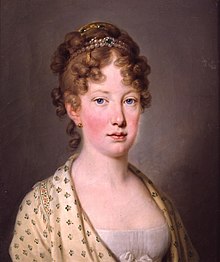
Back Maria Leopoldina Afrikaans ماريا ليوبولدينا النمساوية Arabic María Lleopoldina d'Austria AST ماریا لدوپولدینای آستوریاس AZB Мария-Леополдина Австрийска Bulgarian Maria Leopoldine Aostria Breton Maria Leopoldina d'Àustria (reina de Portugal) Catalan ماریا لیۆپۆڵدینای نەمسا CKB Marie Leopoldina Habsbursko-Lotrinská Czech Maria Leopoldina af Østrig Danish
| Maria Leopoldina of Austria | |||||
|---|---|---|---|---|---|
 Portrait by Joseph Kreutzinger, c. 1815 | |||||
| Empress consort of Brazil | |||||
| Tenure | 12 October 1822 – 11 December 1826 | ||||
| Queen consort of Portugal | |||||
| Tenure | 10 March 1826 – 2 May 1826 | ||||
| Born | 22 January 1797 Hofburg, Vienna, Archduchy of Austria, Holy Roman Empire | ||||
| Died | 11 December 1826 (aged 29) Palace of São Cristóvão, Rio de Janeiro, Empire of Brazil | ||||
| Burial |
| ||||
| Spouse | |||||
| Issue Detail | |||||
| |||||
| House | Habsburg-Lorraine | ||||
| Father | Francis II, Holy Roman Emperor | ||||
| Mother | Maria Theresa of Naples and Sicily | ||||
| Signature | |||||
Dona Maria Leopoldina of Austria (22 January 1797 – 11 December 1826) was the first Empress of Brazil as the wife of Emperor Dom Pedro I from 12 October 1822 until her death. She was also Queen of Portugal during her husband's brief reign as King Dom Pedro IV from 10 March to 2 May 1826.
She was born in Vienna, Austria, the daughter of Holy Roman Emperor Francis II, and his second wife, Maria Theresa of Naples and Sicily. Among her many siblings were Emperor Ferdinand I of Austria and Marie Louise, Duchess of Parma, the wife of Napoleon Bonaparte.
The education Maria Leopoldina had received in childhood and adolescence was broad and eclectic, with a higher cultural level and more consistent political training. Such education of the little princes and princesses of the Habsburg family was based on the educational belief initiated by their grandfather Holy Roman Emperor Leopold II, who believed "that children should be inspired from an early age to have high qualities, such as humanity, compassion and the desire to make people happy".[1] With a deep Christian faith and a solid scientific and cultural background (which included international politics and notions of government) the Archduchess had been prepared from an early age to being a proper royal consort.[1][2][3]
In the 21st century, it has been proposed by some historians that she was one of the main articulators of the process of Independence of Brazil that took place in 1822.[4][5][6] Her biographer, historian Paulo Rezzutti, maintains that it was largely thanks to her that Brazil became a nation. According to him, the wife of Dom Pedro "embraced Brazil as her country, Brazilians as her people and Independence as her cause". She was also adviser to Dom Pedro on important political decisions that reflected the future of the nation, such as the Dia do Fico and the subsequent opposition and disobedience to the Portuguese courts regarding the couple's return to Portugal.[7] Consequently, for governing the country on Dom Pedro's trips through the Brazilian provinces, she is considered the first woman to become head of state in an independent American country.[8][9][10]
- ^ a b Rezzutti 2017, p. 48.
- ^ Rezzutti 2017, pp. 364–365.
- ^ Rezzutti 2017, pp. 369–370.
- ^ "Maria Leopoldina assina o decreto da Independência do Brasil". history.uol.com.br (in Portuguese). September 2013. Archived from the original on 16 October 2022. Retrieved 1 March 2021.
- ^ Buonfiglio, Monica. "A Independência do Brasil decretada por uma mulher". terra.com.br (in Portuguese). Retrieved 16 February 2021.
- ^ Athaide, Guilherme (August 2017). "Como Leopoldina influenciou a política do Brasil e se tornou uma grande imperatriz?". vix.com (in Portuguese). Retrieved 16 February 2021.
- ^ Rezzutti 2017, pp. 206–207.
- ^ Tapioca Neto, Renato (2 September 2017). "Maria Leopoldina da Áustria: a primeira mulher a governar o Brasil Independente". rainhastragicas.com (in Portuguese). Retrieved 16 February 2021.
- ^ Modelli, Laís (10 December 2017). "Quem foi a primeira mulher a governar o Brasil". bbc.com (in Portuguese). Retrieved 16 February 2021.
- ^ "Quem foi a primeira mulher a governar o Brasil". terra.com.br (in Portuguese). Retrieved 16 February 2021.